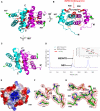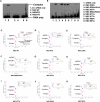Structural implications into dsRNA binding and RNA silencing suppression by NS3 protein of Rice Hoja Blanca Tenuivirus
- PMID: 21460234
- PMCID: PMC3078739
- DOI: 10.1261/rna.2552811
Structural implications into dsRNA binding and RNA silencing suppression by NS3 protein of Rice Hoja Blanca Tenuivirus
Abstract
Rice Hoja Blanca Tenuivirus (RHBV), a negative strand RNA virus, has been identified to infect rice and is widely transmitted by the insect vector. NS3 protein encoded by RHBV RNA3 was reported to be a potent RNAi suppressor to counterdefense RNA silencing in plants, insect cells, and mammalian cells. Here, we report the crystal structure of the N-terminal domain of RHBV NS3 (residues 21-114) at 2.0 Å. RHBV NS3 N-terminal domain forms a dimer by two pairs of α-helices in an anti-parallel mode, with one surface harboring a shallow groove at the dimension of 20 Å × 30 Å for putative dsRNA binding. In vitro RNA binding assay and RNA silencing suppression assay have demonstrated that the structural conserved residues located along this shallow groove, such as Arg50, His51, Lys77, and His85, participate in dsRNA binding and RNA silencing suppression. Our results provide the initial structural implications in understanding the RNAi suppression mechanism by RHBV NS3.
Figures






References
-
- Baumberger N, Tsai CH, Lie M, Havecker E, Baulcombe DC 2007. The Polerovirus silencing suppressor P0 targets ARGONAUTE proteins for degradation. Curr Biol 17: 1609–1614 - PubMed
-
- Bennasser Y, Le SY, Benkirane M, Jeang KT 2005. Evidence that HIV-1 encodes an siRNA and a suppressor of RNA silencing. Immunity 22: 607–619 - PubMed
-
- Bortolamiol D, Pazhouhandeh M, Marrocco K, Genschik P, Ziegler-Graff V 2007. The Polerovirus F box protein P0 targets ARGONAUTE1 to suppress RNA silencing. Curr Biol 17: 1615–1621 - PubMed
-
- Bucher E, Hemmes H, De Haan P, Goldbach R, Prins M 2004. The influenza A virus NS1 protein binds small interfering RNAs and suppresses RNA silencing in plants. J Gen Virol 85: 983–991 - PubMed
Publication types
MeSH terms
Substances
Associated data
- Actions
LinkOut - more resources
Full Text Sources
